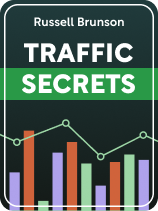

This article is an excerpt from the Shortform book guide to "Traffic Secrets" by Russell Brunson. Shortform has the world's best summaries and analyses of books you should be reading.
Like this article? Sign up for a free trial here.
Are you struggling to get your website noticed on Google? Do you want to boost your online visibility and attract more customers?
In his book Traffic Secrets, Russell Brunson shares valuable insights on Google search/SEO strategies. He emphasizes the importance of quality content and ethical optimization techniques. Brunson’s approach focuses on understanding your target audience and creating content that meets their needs.
Keep reading to discover practical tips for improving your website’s Google search ranking and driving more traffic to your business.
Google Search & SEO
Brunson advises that your marketing strategy must take into account Google search. SEO (search engine optimization) is a must if you want to get more traffic to your site. You should make sure your website ranks highly in Google searches related to your product. Online searches are one of the primary ways people seek out solutions to their problems, so, if your site doesn’t pop up in their search results, they can’t become customers. Such a lack of visibility can mean the difference between financial success or failure.
(Shortform note: Marketing experts agree that your website must rank highly on a Google search—studies show that more than 90% of all website traffic travels through the top of page one in a search result. One reason for this is that people associate the top listings of search results as more credible than others, assuming that if a company has been ranked there, other people consider it important and authentic—an example of social proof, where the collective opinions of others bestow a stamp of approval on something.)
Brunson warns against trying to trick Google’s algorithm by doing things like paying spam sites to link to your website to increase the appearance of backlinks (other websites linking to your site to indicate your site is useful or popular). Even if you happen upon a technique like this that seems to work, Google changes its algorithms regularly to stay ahead of such tactics, and you may find the search engine punishes you (reducing your visibility) for trying to game it.
(Shortform note: Tactics aimed at tricking search engines are called black hat SEO (search engine optimization): unethical attempts to rank a website higher. The manipulated backlinks that Brunson discusses are called unnatural links, and search engines like Google actively penalize websites using such links or other black hat tactics so they don’t interfere with their users’ experience. Once penalized, it can take a website six months or more to recover, so SEO experts recommend, as Brunson does, not risking such approaches.)
Analyze Keywords
Brunson says that instead of trying to trick Google’s algorithm, you should publish quality content that’s specifically designed to bring value to your customers, which is what search engines are ultimately trying to provide their users. As you do so, you can increase the searchability of your content by comparing it to content from existing websites. Start by analyzing keywords:
1. Make a list of the keywords and phrases your dream customer will use to look for a product like yours. Also identify the long-tail keywords associated with these primary keywords—phrases that build on these initial ones that often show up in the Google search bar as you type your keyword. For example, if your dream keyword is remodeling, your long-tail keywords might include remodeling ideas, remodeling kitchen, remodeling contractors, and so on.
(Shortform note: Long-tail keywords can be crucial to a company’s SEO strategy for several reasons. They typically have lower competition than primary keywords, making it easier for businesses to rank higher in those searches. They also often have higher conversion rates—people using longer phrases are typically more informed and invested in their search, and thus closer to the buying stage: These potential customers are more likely to become actual customers.)
2. Do some searches using the keywords you identified to find what websites are currently showing up at the top of those rankings.
3. On your website, publish an article that is similar to the articles that are ranking high on your search but that improves on them. You might do this by publishing a longer article (for example, if the article you’re emulating is “20 Best Vacation Spots,” publish a “50 Best” article). Or, you may write one that’s more updated, more detailed, or better-looking. For best results, improve on all four of these aspects. This is called the “skyscraper” technique, as you’re trying to build a website more visible than others around you.
Be sure to include your keywords in your article.
(Shortform note: The skyscraper approach is often recommended by marketing experts, but it has limitations. To publish an article or webpage that successfully attracts more viewers than existing sites, you must produce content that is not only longer or more detailed but also adds valuable insights or perspectives, which can be hard to do. Simply expanding on existing content without adding unique ideas may not capture people’s attention. Further, in highly competitive niches, there may be an abundance of “skyscraped” content, making it hard for new entrants to stand out. Some critics thus argue that the skyscraper technique is no longer as effective as it once was and may not lead to expected improvements in search rankings.)
4. Figure out what websites are linking to the sites showing up high in your keyword searches. Contact these other sites and ask them if they’d link to your article as well, since yours is similar but better: longer, more updated, more comprehensive, and better laid-out.
5. Further increase backlinks to your article by promoting it on all the social media sites you use, in your email list, and on any guest posts you make for other peoples’ blogs.
6. In addition to trying to elevate your website’s rank, take advantage of the websites that are already highly ranked within your keywords by purchasing ads on them. Brunson writes that people who find your website by clicking on such an ad are far likelier to turn into paying customers than people who find you through a simple Google search—the fact that they’ve clicked on multiple links to get to you shows they’re more motivated.
| The Promise and Limitations of Backlinks Experts agree that backlinks are crucial to your search rankings: On average, websites that rank #1 on Google have 3.8 times as many backlinks as others within the top 10 results. As a result, many SEO consultants advise, as does Brunson, that you devote a lot of attention to gathering backlinks. The process of reaching out to other, more authoritative sources is known as outreach link building. It’s important to note, however, that not all websites may be open to your request. Some have strict editorial policies or guidelines regarding outbound links, while others may require compensation or collaboration for backlink placement. Target, therefore, sites that are relevant to your content and that your website can add value to. Paid ads, such as banner ads, generate backlinks when users click on them, and therefore can also increase your rankings. Since you pay for ads, you’ll need to balance these kinds of backlinks against more organic backlinks when budgeting your marketing funds. Note that Brunson’s advice regarding social media backlinks may no longer be effective. Typically, social media links are marked in a way that search engines don’t recognize them for SEO purposes. |

———End of Preview———
Like what you just read? Read the rest of the world's best book summary and analysis of Russell Brunson's "Traffic Secrets" at Shortform.
Here's what you'll find in our full Traffic Secrets summary:
- Tips to drive traffic to your online business
- How to find the right customers for your business
- The importance of social media for marketing






